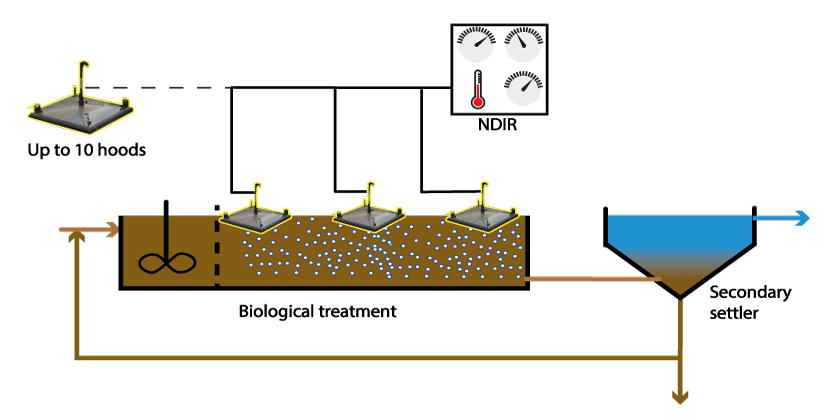Department Process Engineering
N2Oara – Greenhouse gas emissions from wastewater treatment
In the N2Oara project, we develop a monitoring concept for off-gas emission from wastewater treatment. The overall aims of the project are to use the monitoring concept to monitor greenhousegas emissions from wastewater treatment and to show the potential of the concept for operating a wastewater treatment plant. The main advantage of off-gas monitoring is the significantly reduced maintenance effort compared to the measurement in the liquid phase. A particular focus of the project is the quantification of nitrous oxide emissions, the most important greenhouse gas in wastewater treatment.
Monitoring off-gas emissions
In wastewater treatment, usually, off-gas emissions are quantified with floating gas hoods. Various gaseous compounds can be detected in the off-gas, such as nitrous oxide, nitric oxide, methane, carbon dioxide, and oxygen. While most of the gases are important greenhouse gases, the oxygen measurement offers a high potential for the advanced operation and the optimization of the aeration in biological treatment tanks. Here, the off-gas oxygen concentration serves to calculate oxygen uptake rates. The maintenance can be drastically reduced compared to measuring the oxygen concentration in the liquid phase.

Greenhouse gas emissions from wastewater treatment
Wastewater treatment plants are important point sources of greenhouse gases. Typically, three important greenhouse gases are emitted: nitrous oxide (N2O), methane (CH4), and carbon dioxide (CO2). ). In total, Swiss wastewater treatment plants emit 1-2 % of the entire Swiss greenhouse gas emissions according to the Kyoto Protocol. N2O is considered to be the most important emission. In many municipalities, wastewater treatment plants are the most important electricity consumers. However, an optimization of the electricity demand is only reasonable if the the total greenhouse emissions remain constant.
Nitrous oxide emissions
Current long-term monitoring campaigns show that in average 1.7% of the incoming nitrogen load are emitted as N2O. The emissions exhibit a strong seasonal trend. N2O is produced during biological nitrogen removal by biological and chemical processes. The production pathways are generally well characterized. However, the reasons for the strong seasonally dynamics are unknown. A promising tool to better understand the production dynamics is the measurement of isotopic concentration in the N2O atom.
Project goals
The project is aiming (1) to assess representative emission factors for greenhouse gases from wastewater treatment, (2) to characterize influencing factors for N2O emission, (3) to develop a representative and robust gas emission monitoring method based on the floating gas hood approach, (4) to test and propose mitigation strategies, (5) to develop a emission model for national emission accounting, and (6) to show applications for oxygen measurements in the off gas. The interdisciplinary of the project and the different perspectives of the partners allow to tackle questions with integrative approaches. The transition of findings from research to praxis is a key element of the project.
About us
The N2Oara project is an interdisciplinary research project with partners from different sectors:
Research (eawag, Empa, ETH Zürich)
Authorities (FOEN water protection, FOEN greenhousgas inventory, AFU Kt. Bern, AWEL Kt. Zürich)
Operators (Real WWTP, Werdhölzli WWTP, Bern WWTP, Hofen WWTP, Giubiasco WWTP)
Engineers & Consultants (Holinger, Hunziker-Betatech, TBF+Partner)



